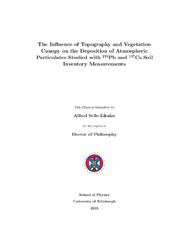| dc.description.abstract | Naturally occurring radioactive isotopes of 210Pb and 7Be in the atmosphere, plant material and soil have been used to investigate the transport and removal of atmospheric aerosols from the atmosphere by precipitation and turbulent deposition to natural surfaces. Concentrations of 210Pb and 7Be contained in aerosols in surface air were measured using a high volume sampler at the King’s Buildings site of the University of Edinburgh (55.9°N, 03.2°W) over a 12 month period (July 2002-June 2003). The log-normally distributed concentrations of 210Pb, with a median of 0.141 mBq m−3 over the monitoring period, indicated a surface source and dispersion by wind. The concentrations were largest in air with trajectories over terrestrial surfaces, consistent with soil as the source, and smallest in air with marine trajectories and also air masses subject to precipitation, the main removal process for aerosol bound 210Pb. Concentrations of 7Be were largest during spring which is consistent with a stratospheric origin and, like 210Pb, concentrations were smaller in air masses subject to precipitation. Measurements of 210Pb and 7Be in tree foliage, precipitation and throughfall water beneath tree canopies were used to investigate the transport pathway of these isotopes from the atmosphere to soil. The measurements showed that the 210Pb aerosols attach and bind effectively to foliar surfaces, so that deposition to soil relies mainly on leaf fall. In open parkland trees, the distribution of the falling leaves determines the deposition of the 210Pb. Foliar surfaces effectively filter 7Be from precipitation as it passes through the woodland canopy. Studies of soil inventories of 210Pb beneath woodland and grassland, undisturbed for several half-lives of the isotope, were used to deduce annual average fluxes, wet deposition, cloud droplet deposition and dry deposition of aerosols onto these surfaces. The measurements showed dry deposition velocities of 210Pb containing aerosols of 7.4 ± 1.8 mm s−1 on mature mixed deciduous woodland, and 2.6 ± 1.3 mm s−1 on grassland, substantially larger than current theoretical values but consistent with much recent work by a range of methods. ii A transect of 210Pb and 137Cs inventories was measured in soil beneath woodland and moorland between the coast of Wales and the summit of Plynlimon (∼700 m asl). Along the transect, precipitation increased by a factor of ∼1.8, whereas 210Pb inventories in moorland soils increased by a factor of 2.4 ± 0.4, consistent with the seeder-feeder scavenging of orographic cloud containing 210Pb concentrations larger than those in seeder precipitation by a factor of 1.3 ± 0.4. | en_US |

